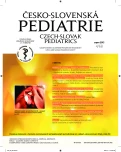Prevalence of overweight and obesity in Bratislava highschool students – preliminary results of study „Respect for Health“
Authors:
R. Kollárová 1; Z. Gerová 2; V. Potičný 3; K. Šebeková 1
Authors‘ workplace:
Ústav molekulárnej biomedicíny, Bratislavaprednosta MUDr. Ing. Mgr. P. Celec, PhD., MPH
1; Regionálny úrad verejného zdravotníctva, Bratislava, Slovenskovedúca odboru MUDr. A. Béderová, CSc.
2; Odbor zdravotníctva Bratislavského samosprávneho kraja, Bratislava, Slovenskoriaditeľ MUDr. V. Potičný, MPH
3
Published in:
Čes-slov Pediat 2013; 68 (4): 211-218.
Category:
Original Papers
Overview
The aim of the ongoing study „Respect for Health“, organized by Bratislava Self-Governing Region in cooperation with the Regional Authority of Public Health in Bratislava, the Slovak Medical University and Faculty of Medicine, Comenius University, is an effective prevention of cardiometabolic health in of high-school students in Bratislava region. In preliminary analysis, we evaluated prevalence of overweight and obesity - the risk factors for serious metabolic diseases even in childhood. Nowadays, in Slovak children and adolescents overweight and obesity are categorized according to age- and sex-specific percentile charts of BMI – the National standards from 2001 published by the Authority of Public Health. Recent, generally accepted standards are based on survey data from 2001, while BMI cut off points for adults remain the same in the long term.
We evaluated data from 2739 probands aged 14–21 years. Students were categorised as underweight, normal weight, overweight and obese, using 4 different criteria - Slovak age- and gender-specific percentile charts of BMI for from 2001, from 1991, according to international cut off points for BMI for children and adolescents, correspon-ding with cut off points for adults, and using body fat percentage. In boys, frequency distributions obtained using different criteria differed significantly. In girls, using standards from 2001, 1991 and international cut off points led to similar distributions. Disregarding chosen criteria, prevalence of overweight and obesity was very hight in both genders, preliminary results indicate 2-to-3-fold increase during the last decade.
Key words:
prevalence of overweight and obesity, adolescents, diagnostic criteria for obesity
Sources
1. http://wp.sos-obezita.sk. Slovenská obezitologická spoločnosť, 2008.
2. Karnik S, Kanekar A. Childhood obesity: a global public health crisis. Int J Prev Med 2012; 3: 1–7.
3. de Wilde JA, van Dommelen P, Middelkoop BJC, et al. Trends in overweight and obesity prevalence in Dutch, Turkish, Moroccan and Surinamese South Asian children in the Netherlands. Arch Dis Child 2009; 94: 795–800.
4. Wang Y, Monteiro C, Popkin BM. Trends of obesity and underweight in older children and adolescents in the United States, Brazil, China, and Russia. Am J Clin Nutr 2002; 75: 971–977.
5. Chinn S, Rona RJ. Prevalence and trends in overweight and obesity in three cross sectional studies of British Children, 1974–94. BMJ 2001; 322: 24–26.
6. Ebbeling CB, Pawlak DB, Ludwig DS. Childhood obesity: public-health crisis, common sense cure. Lancet 2002; 360: 473–482.
7. Rokholm B, Baker JL, Sorensen TIA. The levelling off of the obesity epidemic since the year 1999 – a review of evidence and perspectives. Obes Rev 2010; 11: 835–846.
8. Olds TS, Tomkinson GR, Ferrar KE, et al. Trends in the prevalence of childhood overweight and obesity in Australia between 1985 and 2008. Int J Obes 2010; 34: 57–66.
9. Olds T, Maher C, Zumin S, et al. Evidence that the prevalence of childhood overweight is plateauing: data from nine countries. Int J Pediatr Obes 2011; 6: 342–360.
10. Marinov Z, Nesrstová M, Barčáková U, a spol. Výsledky pětileté činnosti dětské obezitologické ambulance Dětské polikliniky FN Motol a UK 2. LF, Praha. Čes-slov Pediat 2011; 66 (1): 6–11.
11. Lisá L, Kytnarová J, Stožický F, a spol. Doporučený postup prevence a léčby dětské obezity. Čes-slov Pediat 2008; 63 (9): 501–507.
12. Marinov Z. Rizika dětské obezity. Čes-slov Pediat 2009; 64 (3): 141–146.
13. Schwimmer JB, Burwinkle TM, Varni JW. Health-related quality of life of severely obese children and adolescents. JAMA 2003; 289: 1813–1819.
14. John J, Wolfenstetter SB, Wenig CM. An economic perspective on childhood obesity: Recent findings on cost of illness and cost effectiveness of interventions. Nutrition 2012; 28: 829–839.
15. Telesný vývoj detí a mládeže. Výsledky VI. celoštátneho prieskumu v roku 2001. Úrad verejného zdravotníctva SR, 2004.
16. Cole TJ, Bellizzi MC, Flegal KM, et al. Establishing a standard definition for child overweight and obesity worldwide: international survey. BMJ 2000; 320: 1240–1243.
17. Béder I. Fyziológia človeka. Učebnica pre bakalárske a magisterské štúdium v medicíne. Bratislava: Univerzita Komenského, 2005.
18. Watkins DC, Murray LJ, McCarron P, et al. Ten-year trends for fatness in Northern Irish adolescents: the Young Hearts Projects – repeat cross-sectional study. Int J Obes 2005; 29: 579–585.
19. Kautiainen S. Overweight and obesity in adolescence. Secular trends and associations with perceived weight, sociodemographic factors and screen time. Tampere: University of Tampere, School of Public Health, 2008.
20. Gerova Z, Kovacikova H, Psota M, et al. Major cardiovascular risk factors in primary school children: Petrzalka, the „concrete suburb“ of Bratislava. Int Angiol 2012; 31 (3) Suppl 1: 63.
Labels
Neonatology Paediatrics General practitioner for children and adolescentsArticle was published in
Czech-Slovak Pediatrics

2013 Issue 4
Most read in this issue
- Possibilities to influence relapsing infections of respiratory tract by natural immunomodulating therapy
- Diagnostics and intervention in healthy children whose brother or sisters are seriously ill
- The analgesic potential of different types of sugar solutions in prevention of procedural pain in term infants
- Breakfast as a body mass determinant in children at the of 9–10 years
